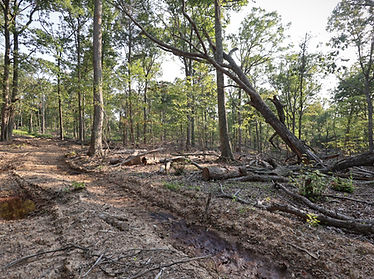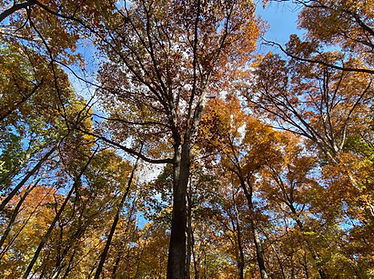

REGENERATIVE FOREST MANAGEMENT
Rolling Ridge Conservancy is working to restore and enhance our forest ecosystem to maximize the ecological benefits of our woodland.

Why a timber harvest?
Rolling Ridge Conservancy has selectively timbered about seventy acres of our woods to favor Oak regeneration and a forest structure that occurs naturally through fire cycles, which are generally suppressed in North America.
The aim is to create diversity of habitat and opportunity for new generations of trees that will set up conditions for a healthier forest.
Why Oaks?
Oaks, generally, are a keystone species in this forest. Keystone species are deeply integrated organisms with critical importance to countless other organisms in the biological system. Were there to be reductions in their populations there would be a dramatic cascading impact on species with lives dependent on the presence of oaks. If we can support the health of oaks by securing space for new trees to germinate and succeed, we ensure the protection and continued presence of countless organisms and relationships necessary in the eastern woodlands.


What can we expect?
Over the coming years we expect to see new tree saplings growing up and filling the forest floor. With a more diverse forest structure there are more opportunities for species less suited to the closed canopy structure found throughout the property and much of our regional forests. The seeded wildflowers will offer opportunities for pollinators and introduction of planted native trees and shrubs in the openings will provide more diversity and potential connections for our current forest species. Movement towards greater diversity in age, structure and available habitat will allow for greater resilience in the biological system in a time of change and uncertainty.
Fire
Managers have observed undesirable changes in vegetation and wildlife when fire is excluded from oak forests. Before suppression, fires could occur every 3 to 10 years in eastern oak forests and woodlands. In the past, eastern oak forests typically were not the dense and dark stands of trees that we see today. Commonly, recurring fires resulted in an appearance like an open park, as fires consumed leaves, woody debris, and small shrubs and trees. Woodlands and savannas contained diverse plant and wildlife communities. Landscapes with plant communities ranging from dense forests to open savannas were the foundation for many levels of diversity for plants, insects, reptiles, birds, and mammals.


Deer
Intensive browsing by deer can reduce vegetation growth rates, ground cover, and species diversity. Even ground nesting songbird abundance may be reduced. Timber harvest that increasing regeneration on the forest floor may reduce browsing pressure on other forest species as more vegetation grows than the deer can browse. However, this effect may be offset if deer density increases. Rolling RIdge Conservancy is thus experimenting with methods to manage the deer browse to increase regeneration. These methods include installing selective deer exclusion structures as shown to allow vegetation to establish on the forest floor.